英语修辞学笔记整理
现代大学英语第五册修辞总结
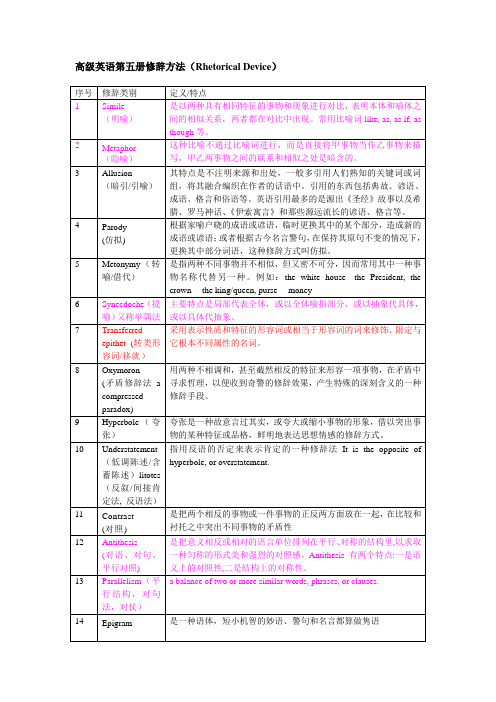
高级英语第五册修辞方法(Rhetorical Device)1. Simile:L1-17: It is something like… behind bars.L1-25: Let us be dissatisfied until from every city hall… a mighty stream.(justice will roll down like waters and righteousness like a mighty stream)L5-5: Same age, same background, but dumb as an ox. (dumb as an ox)L5-50: First he looked at the coat with the expression of a waif at a bakery window. (comparing his longing for the raccoon coat with the expression of a hungry homeless child looking longingly at the bread at a bakery window.)L5-123: It was like digging a tunnel. (comparing his teaching to the hard work of digging a tunnel.)L5-147: I leaped to my feet, bellowing like a bull. (comparing his angry shouts to the bellowing ofa bull)L7-2: …united with others of our country in everything…like the fingers of the hand.(comparing the relationship between black and white to fingers of the hand)L7-10: Yet even then I had been going over my speech...as bright as flame. (comparing each word of his speech to bright flame)L7-16: For in those days I was what they called ginger—colored...like a crisp ginger cookie.(comparing the narrator to a cookie)L7-20: My saliva became like hot bitter glue.L7-21: The boys groped about like blind, cautious crabs... hypersensitive snails. (comparing the black boys to animals)L7-27: A blow to my head as I danced about sent my right eye popping... my dilemma.L7-45: I roiled away as a fumbled football rolls off the receiver’s fingertips...L7-46: 1 was limp as a dish rag.2. Metaphor:L1-5: Psychological freedom. . . physical slavery. (the long night of physical slavery)L1-5: The Negro. . . his own emancipation proclamation. (“signs with the pen and ink of assertive manhood his own emancipation proclamation”)L1-14: … when the unjust… is eliminated. (measurement, a scale of dollars)L1-20: He who hates… ultimate reality. (owning a key to open a door)L1-25: the battering rams of the forces of justice;the junk heaps of historyLet us be dissatisfied until the tragic walls… the forces of justice. (“the tragic walls” and “the battering rams”)L1-27: When our days…into bright tomorrow. (low-hovering clouds of despair; gigantic mountains of evil)L4-3: Killing the Angel in the HouseL4-5: The image of a fishermanL4-7: A room of one’s ownL5-1: There follows an informal essay that ventures even beyond Lamb’s frontier. (comparing the limitation set by Lamb to a frontier)L5-20: My brain, that precision instrument, slipped into high gear. (Mixed metaphor, comparing at the same time the narrator’s brain to a precision instrument and also to a machine that has gears.)L5-34: In other words, if you were out of the picture, the field would be open. (comparing the competing for friendship to an athletic event)L5-98: Maybe somehow I could fan them into flame. Maybe somewhere in the extinct crater of her mind, a few embers still smoldered. (comparing Polly’s mind to the extinct crater of a volcano)L5-115: Poisoning the well: (comparing “the personal attack on a person holding some thesis” to “poisoning the well”)L5-151: The rat. (comparing Petey to a rat)L6-41: I’ve never met anyone… the second time around. (The metaphor of record player is used.)3. Allusion:L1-25: Let us be dissatisfied until that day… none shall be afraid. (a biblical allusion: the 1ion and the lamb shall lie down together; every man will sit under his own vine and fig tree and none shall be afraid)L5-64: We went to the Knoll, the campus trysting place, and we sat down under an old oak… (An implied allusion to Robin Hood, whose trysting place was under a huge oak tree in Sherwood Forest.)L5-138: I was not Pygmalion; I was Frankenstein, and my monster had me by the throat.L10-8: Overnight… surreal episodes…(a sword of Damocles)4. Parody:L10-25: Is our democracy… of liberty? (This is a parody of a line in Patrick Henry’s speech: “Is life so dear or peace so sweet, as to be purchased at the price of chains and slavery?”)5. Metonymy:L4-1: No demand was made upon the family purse. (“purse” stands for money)L4-2: But to show you how little I deserve to be called a professional woman…with my neighbors. (Butcher’s bills stand for meat bought from a butcher. )L5-23: She was, to be sure, a girl who excited the emotions. But 1 was not one to let my heart rule my head. (to let my heart rule my head: Metonymy. “Heart”stands for “feelings and emotions” and “head” for “reason and good sense”.)L5-105: …surgeons have X-rays to guide them during an operation. (X-rays stand for X-rays photographs)L10-2: Anthrax panic… chambers (“Congress” stands for its members)6. Synecdoche:L1-25: Let us be dissatisfied until from every city hall… a mighty stream.city hall (the naming of a part to mean the whole. Here, the naming of the building for the government)L4-2: But to show you how little I deserve to be called a professional woman…with my neighbors. (bread and butter: This set phrase means food and the most important and basic things. )7. Transferred epithet:L1-25: Let us be dissatisfied until the tragic walls… the forces of justice. (the tragic walls)L5-40: I said with a mysterious wink… (the wink was not mysterious)L7-6: our bare upper bodies touching and shining with anticipatory sweat (In “anticipatory sweat”, the adjective “anticipatory “ is a transferred epithet.)L7-25: He kept coming, bringing the rank sharp violence of stale sweat. (the rank sharp violence: Logically rank and sharp modify “stale sweat”, not “violence”.)8. Oxymoron:9. Hyperbole:L5-5: It is not often that one so young has such a giant intellect. (exaggerating for effect)L5-50: … he just stood and stared with mad lust at the coat. (It’s an exaggeration to describe his longing for the coat as “mad lust”)L5-135: You are the whole world to me, and the moon and the stars and the constellations of outer space.L5-135: I will wander the face of the earth, a shambling, hollow-eyed hulk.10. Understatement or litotes:L5-61: This loomed as a project of no small dimensions, and at first 1 was tempted to give her back to Petey. (no small dimensions)11. Contrast:L3-22: A contrast is made between old Shanghai and Shanghai in the 1990s.L8-3: While Oppenheimer was interrupting…. had invented the subject. (an implied contrast)L10-25: How do we… poise? (paranoia vs. poise)12. Antithesis:L1-5: As long as. . . can never be free. (mind vs. body, enslaved vs. free)L1-5: Psychological freedom. . . physical slavery. (psychological freedom vs. physical slavery)L1-7: …love is identified… denial of love (1ove vs. power, a resignation of power vs. denial of love)L1-19: For through violence… but you can’t murder hate. (You may murder a murderer but you can’t murder murder.)L1-25: outer city of wealth and comfort vs. inner city of poverty and despair;wealth vs. poverty (economic);comfort vs. despair(mood, psychology)dark yesterdays vs. bright tomorrows;segregated schools vs. integrated educationon the basis of the content of their character vs. on the basis of the color of their skincontent(substance) vs. color (superficial)character(fundamental) vs. skin (outward appearance)L1-27: When our days…into bright tomorrow.dark yesterday VS. bright tomorrowL5-27: It is, after all, easier to make a beautiful dumb girl smart than to make an ugly smart girl beautiful.beautiful dumb vs. ugly smartL5-50: Back and forth his head swiveled, desire waxing, resolution waning.Desire waxing vs. resolution waningL5-153: Look at me—a brilliant student, a tremendous intellectual, a man with an assured future.Look at Petey—a knot-head, a jitterbug, a guy who’ll never know where his next meal is coming from.Brilliant, intellectual and assured vs. knot-head, jitterbug and never know where his next meal is coming from”13. Parallelism:L1-6: … confrontation of the forces… the status quo.forces of power demanding change(present participle)forces of power dedicated to the preserving of the(past participle) status quoL1-8: What is needed… and anemic.power without love is reckless and abusivelove without power is sentimental and anemicL1-8: Power at its best… against love.power at its best love implementing demands of justicejustice at its best power correcting against loveL1-10: And, in the thinking of that day…moral fiber.the absence of vs. a want ofworldly goods vs. (qualities)L1-19: For through violence… but you can’t murder hate.Three sentences “T hrough violence you may murder… but you can’t murder…”L1-20: And I have seen too much hate…. too great a burden to bear.I have seen too much hateI’ve seen too much hate onI’ve seen hate on…too many Klansmen…L1-25: There are 11 sentences beginning with “let us be dissatisfied until” and two short sentences of “let us be dissatisfied”.L12-5: The armies of… The legions of…The armies of… are marshaled against it.The legions of… will march against it.L12-16: A novelist’s characters… celebrity.a novelist’s characters hope for immortalitya profile journalist’s for celebrityL12-24: It is the disrespect… to preserve.(disrespect) for powerorthodoxiesparty linesideologies…;that I would like to celebratethat I urge all to preserve14. Epigram:L1-20: He who hates… ultimate reality.15. Paradox:L1-18: Without recognizing this…that don’t explain.paralleled paradoxes: solutions that don’t solveanswers that don’t answerexplanations that don’t explainL1-27: When our days…into bright tomorrow. (to make a way out of no way)16. Chiasmus:L1-9: It is precisely this collision… of our times. (immoral power vs. powerless morality)L6-6: Absence of evidence is not evidence of absence.17. Anaphora:L1-25: let us be dissatisfied…18. Alliteration:L1-25: Let us be dissatisfied until that day… none shall be afraid. ( lion, lamb, lie)L7-2: Live with your head in the lion’s mouth...or bust wide open. (death and destruction)L7-9: Some of the others tried to stop them…slipping and sliding over the polished floor.(slipping and sliding)19. Onomatopoeia:L3-14: clickRhetorical Devices一、明喻(simile)是以两种具有相同特征的事物和现象进行对比,表明本体和喻体之间的相似关系,两者都在对比中出现。
英语 修辞笔记
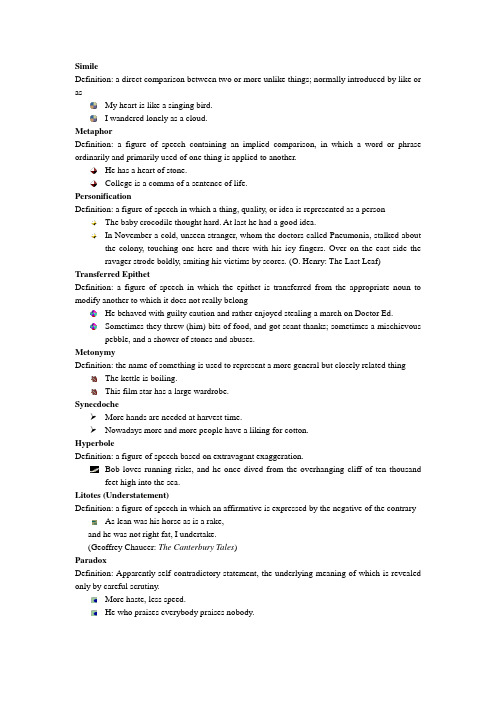
SimileDefinition: a direct comparison between two or more unlike things; normally introduced by like or asMy heart is like a singing bird.I wandered lonely as a cloud.MetaphorDefinition: a figure of speech containing an implied comparison, in which a word or phrase ordinarily and primarily used of one thing is applied to another.He has a heart of stone.College is a comma of a sentence of life.PersonificationDefinition: a figure of speech in which a thing, quality, or idea is represented as a person The baby crocodile thought hard. At last he had a good idea.In November a cold, unseen stranger, whom the doctors called Pneumonia, stalked about the colony, touching one here and there with his icy fingers. Over on the east side the ravager strode boldly, smiting his victims by scores. (O. Henry: The Last Leaf) Transferred EpithetDefinition: a figure of speech in which the epithet is transferred from the appropriate noun to modify another to which it does not really belongHe behaved with guilty caution and rather enjoyed stealing a march on Doctor Ed.Sometimes they threw (him) bits of food, and got scant thanks; sometimes a mischievouspebble, and a shower of stones and abuses.MetonymyDefinition: the name of something is used to represent a more general but closely related thing The kettle is boiling.This film star has a large wardrobe.SynecdocheMore hands are needed at harvest time.Nowadays more and more people have a liking for cotton.HyperboleDefinition: a figure of speech based on extravagant exaggeration.Bob loves running risks, and he once dived from the overhanging cliff of ten thousand feet high into the sea.Litotes (Understatement)Definition: a figure of speech in which an affirmative is expressed by the negative of the contrary As lean was his horse as is a rake,and he was not right fat, I undertake.(Geoffrey Chaucer: The Canterbury Tales)ParadoxDefinition: Apparently self-contradictory statement, the underlying meaning of which is revealed only by careful scrutiny.More haste, less speed.He who praises everybody praises nobody.ParallelismIt consists of phrases or sentences of similar construction and meaning placed side by side, balancing each other.Studies serve for delight, for ornament, and for ability.AntithesisDefinition: Contrast of ideas expressed by parallelism of strongly contrasted words.A mother takes twenty years to make a man of her boy, and another woman takes twenty minutes to make a fool of him .AlliterationDefinition:the commencement of two or more words of a word group with the same letter.Don’t speak humming and hawing, but speak out.Love’s Labour’s Lost. (by Shakespeare)AnaphoraChildren are a comfort, children are amusing, and children are sometimes a nuisance. ChiasmusDefinition: a device that consists of two balanced statements, the second of which reverses the order of the words in the first, with or without a repetition of words.Eat to live, and not live to eat. (Benjamin Franklin)Irony (反语)Definition: a figure of speech in which the intended meaning is the opposite of that expressed by the words used; usually taking the form of sarcasm or ridicule in which laudatory expressions are used to imply condemnation or contempt.Eg. If people keep telling you to quit smoking cigarette, don’t listen… They’re probably trying to trick you into living.Innuendo(暗讽)Definition: a mild form of irony, hinting in a rather roundabout way at something disparaging or uncomplimentary to the person or subject mentioned.Eg. ---It’s rather cold today, isn’t it?---But the weatherman said it would be warm. He must take his readings in a bathroom!Sarcasm(讽刺)A mild form of irony, it is just the opposite. It attacks in a taunting and bitter manner, andits aim is to disparage, ridicule and wound the feelings of the subject attacked.Magnus Frankly, I have been accustomed to regard your President as a statesman whose mouth was the most efficient part of his head.Pun(双关)The use of a word in such a way as to suggest two or more meanings or different associations, or the use of two or more words of the same or nearly the same sound with different meanings, so as to produce a humorous effect.On Sunday they pray for you and on Monday they prey on you!We must all hang together, or we shall all hang separately.Parody(仿拟)Wall Street owns the country. It is no longer a government of the people, by the people and for the people, but a government of Wall Street , by Wall Street and for Wall Street.Give me Green World, or give me yesterday.Give me liberty, or give me death!(Patrick Henry)Onomatopoeia(拟声)Father always chuckles when he reads the funny papers.Ladies cackled constantly at the cock-tail party.。
高级英语修辞手法总结(最常考)
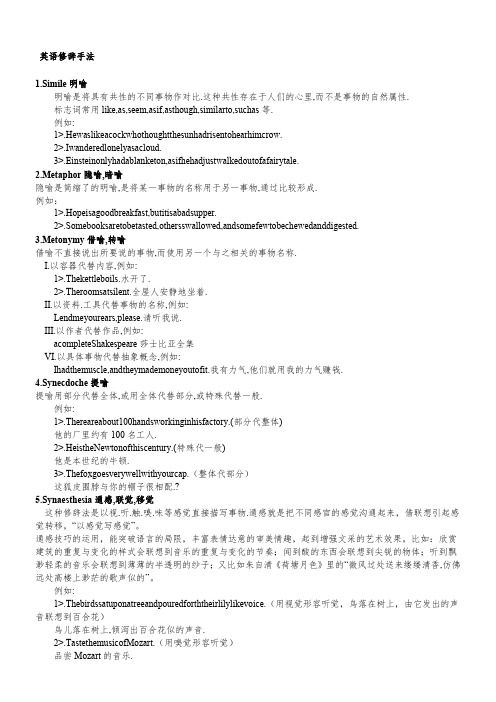
英语修辞手法1.Simile明喻明喻是将具有共性的不同事物作对比.这种共性存在于人们的心里,而不是事物的自然属性.标志词常用like,as,seem,asif,asthough,similarto,suchas等.例如:1>.Hewaslikeacockwhothoughtthesunhadrisentohearhimcrow.2>.Iwanderedlonelyasacloud.3>.Einsteinonlyhadablanketon,asifhehadjustwalkedoutofafairytale.2.Metaphor隐喻,暗喻隐喻是简缩了的明喻,是将某一事物的名称用于另一事物,通过比较形成.例如:1>.Hopeisagoodbreakfast,butitisabadsupper.2>.Somebooksaretobetasted,othersswallowed,andsomefewtobechewedanddigested.3.Metonymy借喻,转喻借喻不直接说出所要说的事物,而使用另一个与之相关的事物名称.I.以容器代替内容,例如:1>.Thekettleboils.水开了.2>.Theroomsatsilent.全屋人安静地坐着.II.以资料.工具代替事物的名称,例如:Lendmeyourears,please.请听我说.III.以作者代替作品,例如:acompleteShakespeare莎士比亚全集VI.以具体事物代替抽象概念,例如:Ihadthemuscle,andtheymademoneyoutofit.我有力气,他们就用我的力气赚钱.4.Synecdoche提喻提喻用部分代替全体,或用全体代替部分,或特殊代替一般.例如:1>.Thereareabout100handsworkinginhisfactory.(部分代整体)他的厂里约有100名工人.2>.HeistheNewtonofthiscentury.(特殊代一般)他是本世纪的牛顿.3>.Thefoxgoesverywellwithyourcap.(整体代部分)这狐皮围脖与你的帽子很相配.?5.Synaesthesia通感,联觉,移觉这种修辞法是以视.听.触.嗅.味等感觉直接描写事物.通感就是把不同感官的感觉沟通起来,借联想引起感觉转移,“以感觉写感觉”。
英语修辞手法总结
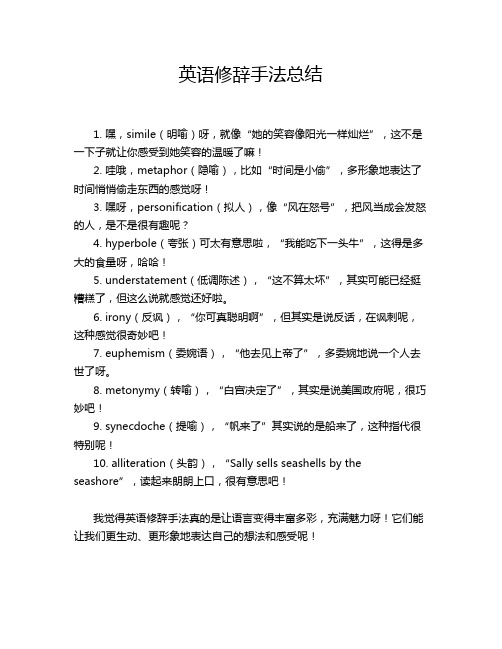
英语修辞手法总结
1. 嘿,simile(明喻)呀,就像“她的笑容像阳光一样灿烂”,这不是一下子就让你感受到她笑容的温暖了嘛!
2. 哇哦,metaphor(隐喻),比如“时间是小偷”,多形象地表达了时间悄悄偷走东西的感觉呀!
3. 嘿呀,personification(拟人),像“风在怒号”,把风当成会发怒的人,是不是很有趣呢?
4. hyperbole(夸张)可太有意思啦,“我能吃下一头牛”,这得是多大的食量呀,哈哈!
5. understatement(低调陈述),“这不算太坏”,其实可能已经挺糟糕了,但这么说就感觉还好啦。
6. irony(反讽),“你可真聪明啊”,但其实是说反话,在讽刺呢,这种感觉很奇妙吧!
7. euphemism(委婉语),“他去见上帝了”,多委婉地说一个人去世了呀。
8. metonymy(转喻),“白宫决定了”,其实是说美国政府呢,很巧妙吧!
9. synecdoche(提喻),“帆来了”其实说的是船来了,这种指代很特别呢!
10. alliteration(头韵),“Sally sells seashells by the seashore”,读起来朗朗上口,很有意思吧!
我觉得英语修辞手法真的是让语言变得丰富多彩,充满魅力呀!它们能让我们更生动、更形象地表达自己的想法和感受呢!。
英语修辞学知识要点
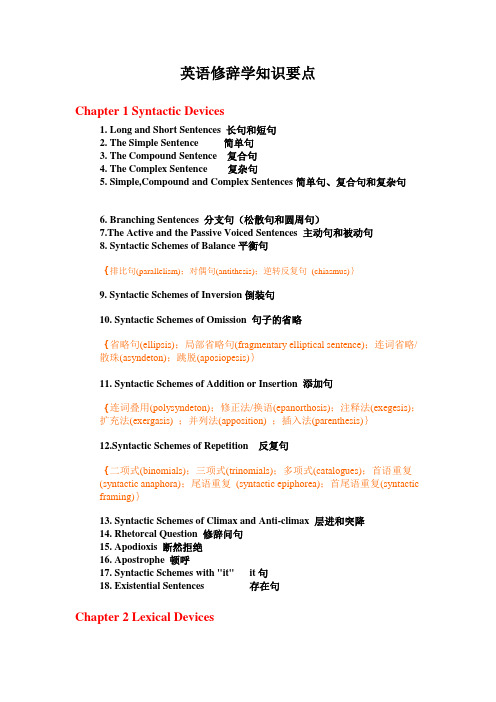
英语修辞学知识要点Chapter 1 Syntactic Devices1. Long and Short Sentences 长句和短句2. The Simple Sentence 简单句3. The Compound Sentence 复合句4. The Complex Sentence 复杂句5. Simple,Compound and Complex Sentences简单句、复合句和复杂句6. Branching Sentences 分支句(松散句和圆周句)7.The Active and the Passive Voiced Sentences 主动句和被动句8. Syntactic Schemes of Balance平衡句{排比句(parallelism);对偶句(antithesis);逆转反复句(chiasmus)}9. Syntactic Schemes of Inversion倒装句10. Syntactic Schemes of Omission 句子的省略{省略句(ellipsis);局部省略句(fragmentary elliptical sentence);连词省略/散珠(asyndeton);跳脱(aposiopesis)}11. Syntactic Schemes of Addition or Insertion 添加句{连词叠用(polysyndeton);修正法/换语(epanorthosis);注释法(exegesis);扩充法(exergasis) ;并列法(apposition) ;插入法(parenthesis)}12.Syntactic Schemes of Repetition 反复句{二项式(binomials);三项式(trinomials);多项式(catalogues);首语重复(syntactic anaphora);尾语重复(syntactic epiphorea);首尾语重复(syntactic framing)}13. Syntactic Schemes of Climax and Anti-climax 层进和突降14. Rhetorcal Question 修辞问句15. Apodioxis 断然拒绝16. Apostrophe 顿呼17. Syntactic Schemes with "it" it句18. Existential Sentences 存在句Chapter 2 Lexical Devices1.Lexical optionsShort words or long words 长短词Common words or learned words 普通词和书面词Formal,informal or colloquial words 正式词、非正式词和口语词General or specific words 一般词和特殊词Concrete or abstract words 具体词和抽象词Referential or emotive words 指称词和情感词Choice between synonymous words 近义词的选择2.choice of abbreviationsAcronyms 首字母缩略词ClippingsBlends 混合词3.Lexical repetitionImmediate repetition连接反复Lexical anaphora 首语反复Lexical epistrophe 尾语反复Symploce首尾语反复Anadiplosis链形反复distant or intermitten repetition间隔反复root repetition 词根反复ploce换义反复Chapter 3 Phonetic Devices and Prose Rhythm 1. Phonetic Devices语音词格Alliteration头韵Assonance元韵Consonance 辅韵Homeoteleuton谐缀格Onomatopoeia拟声Combined use of Phonetic Devices2. Prose Rhythm散文节奏Stress重音Pitch语调Pause and tempo停顿和语速Chapter 4 Figures of Speech1.Simile明喻2.Metaphor暗喻3.Analogy类比4.Personification\physicalification拟人\拟物5.Metonymy借代6.Synecdoche提喻7.Antonomasia换称8.Syllepsis一笔双叙9.Zeugma轭式搭配10.Paradox隽语11.Oxymoron矛盾修饰法12.Hyperbole夸张13.Understatement低调陈述14.Euphemism委婉语15.Irony反语16.Innuendo讥讽17.Sarcasm讽刺18.Transferred Epithet 移就19.Pun双关(antanaclasis语音双关;paronomasia语义双关)20.Epigram警句21.synesthesia通感22.palindrome 回文Chapter 5 Allusions典故的来源和改引。
英语修辞手法总结
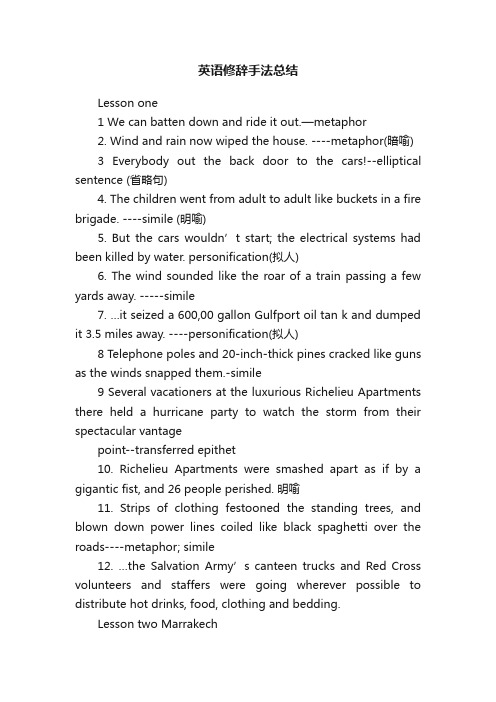
英语修辞手法总结Lesson one1 We can batten down and ride it out.—metaphor2. Wind and rain now wiped the house. ----metaphor(暗喻)3 Everybody out the back door to the cars!--elliptical sentence (省略句)4. The children went from adult to adult like buckets in a fire brigade. ----simile (明喻)5. But the cars wouldn’t start; the electrical systems had been killed by water. personification(拟人)6. The wind sounded like the roar of a train passing a few yards away. -----simile7. …it seized a 600,00 gallon Gulfport oil tan k and dumped it 3.5 miles away. ----personification(拟人)8 Telephone poles and 20-inch-thick pines cracked like guns as the winds snapped them.-simile9 Several vacationers at the luxurious Richelieu Apartments there held a hurricane party to watch the storm from their spectacular vantagepoint--transferred epithet10. Richelieu Apartments were smashed apart as if by a gigantic fist, and 26 people perished. 明喻11. Strips of clothing festooned the standing trees, and blown down power lines coiled like black spaghetti over the roads----metaphor; simile12. …the Salvation Army’s canteen trucks and Red Cross volunteers and staffers were going wherever possible to distribute hot drinks, food, clothing and bedding.Lesson two Marrakech1 The little crowd of mourners -- all men and boys, no women--threaded their way across the market place between the piles of pomegranates and the taxis and the camels, walling a short chant over and over again. (Elliptical sentence省略句)2 提喻or are they merely a kind of undifferentiated brown stuff, about as individual as bees or coral insects?3 押头韵They rise out of the earth, they sweat and starve fora few years, and then they sink back into the nameless mounds of the graveyard (Para 3)4间接请求I could eat some of that bread.5夸张移就暗喻A carpenter sits cross-legged at a prehistoric lathe, turning chair-legs at lightning speed.(Transferred epithet 移就Metaphor暗喻)6移就暗喻Instantly, from the dark holes all round, there wasa frenzied rush of Jews. (Transferred epithet 移就)7 类比in just the same way, a couple of hundred years ago, poor old women used to be burned for witchcraft when they could not even work enough magic to get themselves a square meal.7 提喻still, a white skin is always fairly conspicuous.8 明喻long lines of women, bent double like inverted capital Ls.9 暗喻she accepted her status as an old woman, that is to say as a beast of burden.10 拟声词Onomatopoeia as the strokes flew northward the Negroes were marching southward -a long, dusty column, infantry, screw- gun batteries, and then more infantry, four or five thousand men in all, winding up the road with a clumping of boots and a clatter of iron wheels.11 明喻their feet squashed into boots that looks like blocks of wood…Sim ile12 省略句Not hostile, not contemptuous, not sullen, not even inquisitive13 明喻And really it was like watching a flock of cattle to see the long column, a mile or two miles of armed men, flowing peacefully up the road, while the great white birds drifted over them in the opposite direction, glittering like scrapes of paper.Lesson threeMetaphor(暗喻)1 the conversation had swung from Australian convicts of the 19th century to the english peasants of the 12th century.2 the conversation was on wings.3.And no one has any idea where it will go as it meander or leaps and sparkles or just glows .——mixed metaphor4The fact that their marriages may be on the rocks,or that their love affairs have been broken or even that they got out of bed on the wrong side is simply not a concern.——metaphor 【1.on the rock 为英语习语,这里引用了隐喻的修辞手法,把婚姻比喻成触礁的船只】【2.to get out of the bed on the wrong side 也是英语习语。
高级英语中的修辞手法总结带课文中例句
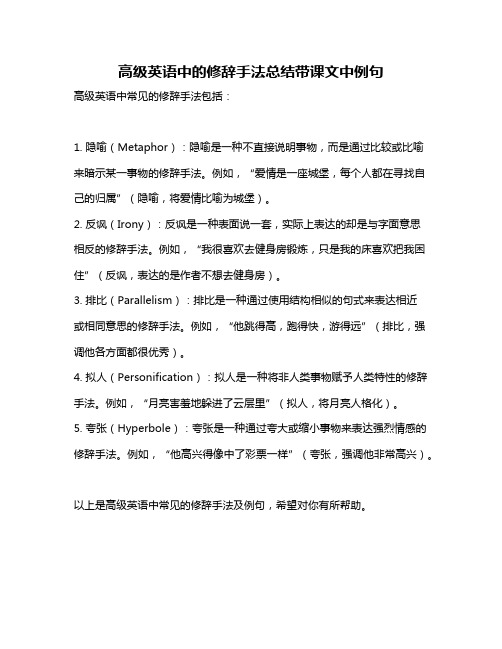
高级英语中的修辞手法总结带课文中例句
高级英语中常见的修辞手法包括:
1. 隐喻(Metaphor):隐喻是一种不直接说明事物,而是通过比较或比喻来暗示某一事物的修辞手法。
例如,“爱情是一座城堡,每个人都在寻找自己的归属”(隐喻,将爱情比喻为城堡)。
2. 反讽(Irony):反讽是一种表面说一套,实际上表达的却是与字面意思
相反的修辞手法。
例如,“我很喜欢去健身房锻炼,只是我的床喜欢把我困住”(反讽,表达的是作者不想去健身房)。
3. 排比(Parallelism):排比是一种通过使用结构相似的句式来表达相近
或相同意思的修辞手法。
例如,“他跳得高,跑得快,游得远”(排比,强调他各方面都很优秀)。
4. 拟人(Personification):拟人是一种将非人类事物赋予人类特性的修辞手法。
例如,“月亮害羞地躲进了云层里”(拟人,将月亮人格化)。
5. 夸张(Hyperbole):夸张是一种通过夸大或缩小事物来表达强烈情感的修辞手法。
例如,“他高兴得像中了彩票一样”(夸张,强调他非常高兴)。
以上是高级英语中常见的修辞手法及例句,希望对你有所帮助。
英语修辞归纳

一、Figure of Emphasis强调修辞1.Repetition 重复1.1. Immediate Repetition连续重复Scrooge went to bed again, and thought, and thought, and thought it over and over, and could make nothing of it.1.2. Intermittent repetition间隔重复When Della had finished crying, she went to the window and looked out sadly at a grey cat walking along a grey fence in a grey backyard.1.2.1.Anaphora 首语重复Let that be realized. No survival for the British Empire, no survival for all that the British Empire has stood for, no survival for the urge, the impulse of the ages that mankind shall move forward toward his goal.1.2.2.Epiphora 尾语重复… and that government of the people, by the people, and for the people.1.2.3.Simploce/ Epidiplosis首尾重复( a combination of anaphora and epiphora)Broadly speaking, human beings may be divided into three classes: those who are toiled to death, those who are worried to death, and those who are bored to death1.2.4.Anadiplosis 联珠/顶真/尾首反复运用顶真修辞手法,不但能使句子结构整齐,语气贯通,而且能突出事物之间环环相扣的有机联系。
- 1、下载文档前请自行甄别文档内容的完整性,平台不提供额外的编辑、内容补充、找答案等附加服务。
- 2、"仅部分预览"的文档,不可在线预览部分如存在完整性等问题,可反馈申请退款(可完整预览的文档不适用该条件!)。
- 3、如文档侵犯您的权益,请联系客服反馈,我们会尽快为您处理(人工客服工作时间:9:00-18:30)。
英语修辞学
Ⅰ. Phonetic figure of speech 语音修辞
1.Alliteration 押头韵
Bread not bombs.
Cut crimes with jobs not jails.
Time and tide waits for no man.
2.Assonance 押元音
Let us help you extend yourself.
Could anything ever replace the taste of old grape and apple juice. Haste makes waste.
Spend dime save your time.
3.Consonance
Women don’t angonize,organize.
Farms not arms.
4.Aposiopesis 中间间断法
Another step forward,you will…
5.Pun 双关
To Engla nd I will steal,and there I’ll steal.
If we don’t hang together,we hang separately.
On Sunday they pray for you,on Monday they prey on you.
You earn your living.You urn your dead.
Ⅱ.Syntactic figure of speech句法修辞
1. Repetition 重复
There is no,no,no,life.
2. Anaphora 句首重复
I want to know,I want to know who is the girl.
3.Epiphora 句尾重复
Reading makes a full man,conference a ready man and writing an exact man.
4.Simploce 首尾重复
Those who are toil to death,those who are worried to death,those who are bored to death.
5.Parallelism 平行结构
It was not anger,nor surprise,nor disapproval,nor horror,nor any of emotions that she has been prepared for.
Kind hearts are the gardens,kind thoughts are the roots,kind words are the flowers,kind deeds are the fruits.
6.Antithesis 对照
It was the season of light,it was the season of darkness;it was the spring of hope,it was the winter of despair.
When poverty comes in at the door,love flies out of at the window.
7.Climax 高潮
I came,I saw, I conquer.
I was born American,I live American,I shall die American.
8.Anticlimax 反高潮突降法
Where shall I find hope,happiness,friends,cigarette,burp.
9.Syllepsis 一语双叙
He lost his coat and temper.
She opened the door and her heart to the homeless child.
10.Zeugma 轭式修饰法
To make flying more comfortable,we want to great lenghths and great widths.
11.Chiasmus 交错排列法
One should eat to live not live to eat.
For my thoughts are not your thoughts,neither are your wise are my wise.
12.Rhetorical question 反问
If winter comes,can sping be far behind?
Ⅲ.Semantic figure of speech语意修辞
1. Simile 明喻
As cool as cucumber (泰然自若)
Like a hen on the griddle
What A is to B,C is to D.
A fool can no more see his own folly than he can see his ears.
Love and cough can not be hid.
2. Metaphor 暗喻
The world is a stage.
All the world’s a stage,and all the men and women merely players. Money is a bottomless sea,in which honour,conscience and truth may be drowed.
Some books are to be tasted,others to be swallowed,and some few to be chewed and digested.
Books are the ever-burning lamps and wisdom.
3.Personification 拟人
Australia is so kind,just trickle her with a hoe and she laughs with a harvest.
Laziness travels so slowly.
4.Metonymy 转喻
To read a Shakespeare or a Mark Twain is to eat a food full of protein. Without sweat,without bread.
A hundred bayonet were marching.
5.Synecdoche 提喻
The farm is short of hands.
There are hundreds of sails in the harbor.
The prisoner is in irons.
The poor man had six mouths to feed.
China beat Japan at volleyball.
6.Euphemism 委婉语
His wife is expecting another child.
7.Parody 仿写
I had no outlook but an uplook rather.My place in society was at bottom.
8.Synesthesia 共感
The rooms on the first floor are cold color.
9.Transfered epithet 移就
I speak to him in hesitant French.
A sleepless night
A happy day
Ⅳ.Logical figure of speech逻辑修辞
1. Allusion 引喻
He met his Waterloo in 1940s.
2. Hyperbole 夸张
I was destroyed fatigue.
3.Irony 讽刺
We’re luck it’s the other side on the 13th of December.That makes us feel real good.
For instance the nuns who never take a bath without a bathrobe all the time,when asked why,since no man can see them they reply“Oh,but you forget the good God.”
4.Oxymoron 矛盾修饰
Bitter sweat
Victorious defeat
True lie
Loyal deceit
Tearful joy
5.Paradox 自相矛盾
A strong man knows his weakness.
6.Overstatement 高调论述
Bob loves running risks,and he once dived from the overhanging cliff ,often thousand feet high into the sea.
7.Understatement 低调论述
He is no fool.
That civil servant was not without ambition.。
